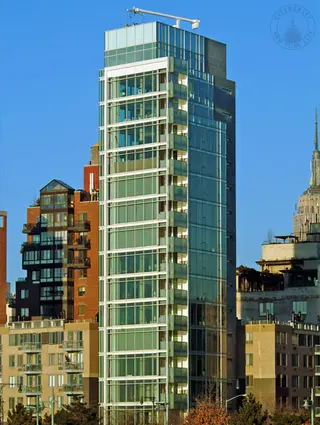 Carter Horsley
Carter HorsleyDec 23, 2011
Carter's Review
173 Perry Street was the first of three mid-rise residential condominium buildings facing the Hudson River designed by Richard Meier.
It and 176 Perry Street were completed in 2002 and were developed by Richard Born, Ira Drukier and Charles Blaichman.
The third tower, 165 Charles Street, just to the south of the first two, was completed in 2005 and developed by Izak Senbahar and Simon Elias.
176 Perry Street is wider than 173 Perry Street and the two very similar towers set a new design standard for mid-rise residential buildings in Manhattan.
Mr. Meier was one of the "New York Five" architects who came to prominence in the late 1960s and early 1970's and were influenced by the clean and bright lines of Le Corbusier. (The other four were Michael Grave, Peter Eisenman, the late Charles Gwathmey, and the late John Hedjuk.)
Bottom Line
These elegant, mid-rise, riverfront Richard Meier apartment buildings significantly reinforced the lower Hudson River waterfront as the neighborhood of choice for the “hip” and “chic.” Although the design of these towers was conservative given the contemporary state of architecture around the world, it was very classy for the city, sort of a white- and mini-Seagram Building aesthetic of nicely proportioned grids and sharp lines.
Description
The Perry Street towers are not identical twins. The west façade of the south tower is slightly broader than that of the north tower. (The Charles Street tower is even broader, which makes for a more interesting enclave).
The façades of these Meier buildings combine floor-to-ceiling windows encased in white steel with slim spandrels and the southwest corners of the Perry Street towers have small frosted-glass balconies. The white steel elements of the Perry Street towers protrude a bit, giving them a handsome texture.
The western façades have a white-steel "frame" that extends beyond the building at the southwest corner and is in front of the balconies that extend even further. The extended frame is gratuitous but not glaringly offensive. The north tower, which is the narrowest, has one apartment per floor while the south tower has two apartments.
Both buildings are set in minimalist gray granite plazas and have handsome entrance canopies.
They are across West Street from the Hudson River Park, which opened about the same time and is very attractive.
In his review of the Perry Street buildings in the June 19, 2003 edition of The New York Times, Herbert Muschamp wrote that the buildings embody “the quality of radiance: the Apollonian virtues of clarity, order, simplicity and light,” adding that Meier was now working with “A formal vocabulary that once seemed constrained by the dogmas of the International Style now stands for freedom from the woollier rhetoric of the postmodern 1980s.”
He praised the “pristine delicacy of the exterior’s white metal frames,” adding that the two towers struck him as “a pair of Hitchcock blondes” and that inside the two buildings were “fireworks…full of racy Rear Windows.” “I do believe that’s Miss Torso up there, practicing jazz dance right now. Soon to be joined by Nicole Kidman, Calvin Klein, Jean Georges Vongerichten and I forget the rest. How will they handle window treatments. The world anxiously awaits,” he continued.
Amenities
This building has a concierge and health club, but no sundeck.
Apartments
Apartments in both of the Perry Street buildings were offered as “raw space.”
Windows have three layers of insulated glass and apartments have 11-foot ceilings and balconies.
Apartments have entrance foyers that lead to a long gallery on the north side of the building that leads to a 40-foot-wide living/dining area and a pass-through kitchen. A 17-foot-long bedroom is on the south side of the building.
One variation has a curved foyer that leads around a curved pass-through kitchen to a 36-foot-long living room adjacent to a large dining area with two bedrooms on the south side of the building.
History
Richard Meier is famous for his 1970 renovation of a former Bell Labs building in the West Village for the Westbeth artists and West and Bethune Streets, his design of the huge Getty Center in Los Angeles, and the High Museum in Atlanta, Georgia.
The "mini" "twins" of the first two buildings in this enclave attracted many celebrities including Martha Stewart who bought the penthouse.
They also conjured memories of the fallen Twin Towers of the World Trade Center that were demolished in the terrorist attacks of September 11, 2001 and were seen by some as symbolizing the city’s will to persevere.
Each floor at 173 Perry Street contains about 1,800 square feet but at 176 Perry Street each floor is about 3,750 square feet. An article in the June 2004 issue of Vanity Fair magazine by Vicky Ward Ms. Ward wrote that one resident said “we call it the poor persons’ tower.” Not only was it larger with more expensive apartments, but it also usurped many of 173 Perry’s views of Lower Manhattan to the south.
Those views at 176 Perry Street, however, would be largely obstructed by the addition of a third building designed by Meier on the block just to the south for a different set of developers at 165 Charles Street.

- Condo built in 2002
- Located in West Village
- 16 total apartments 16 total apartments
- 10 recent sales ($4.4M to $8.1M)
- Doorman
- Small Pets Allowed only
 6sqft delivers the latest on real estate, architecture, and design, straight from New York City.
6sqft delivers the latest on real estate, architecture, and design, straight from New York City.
